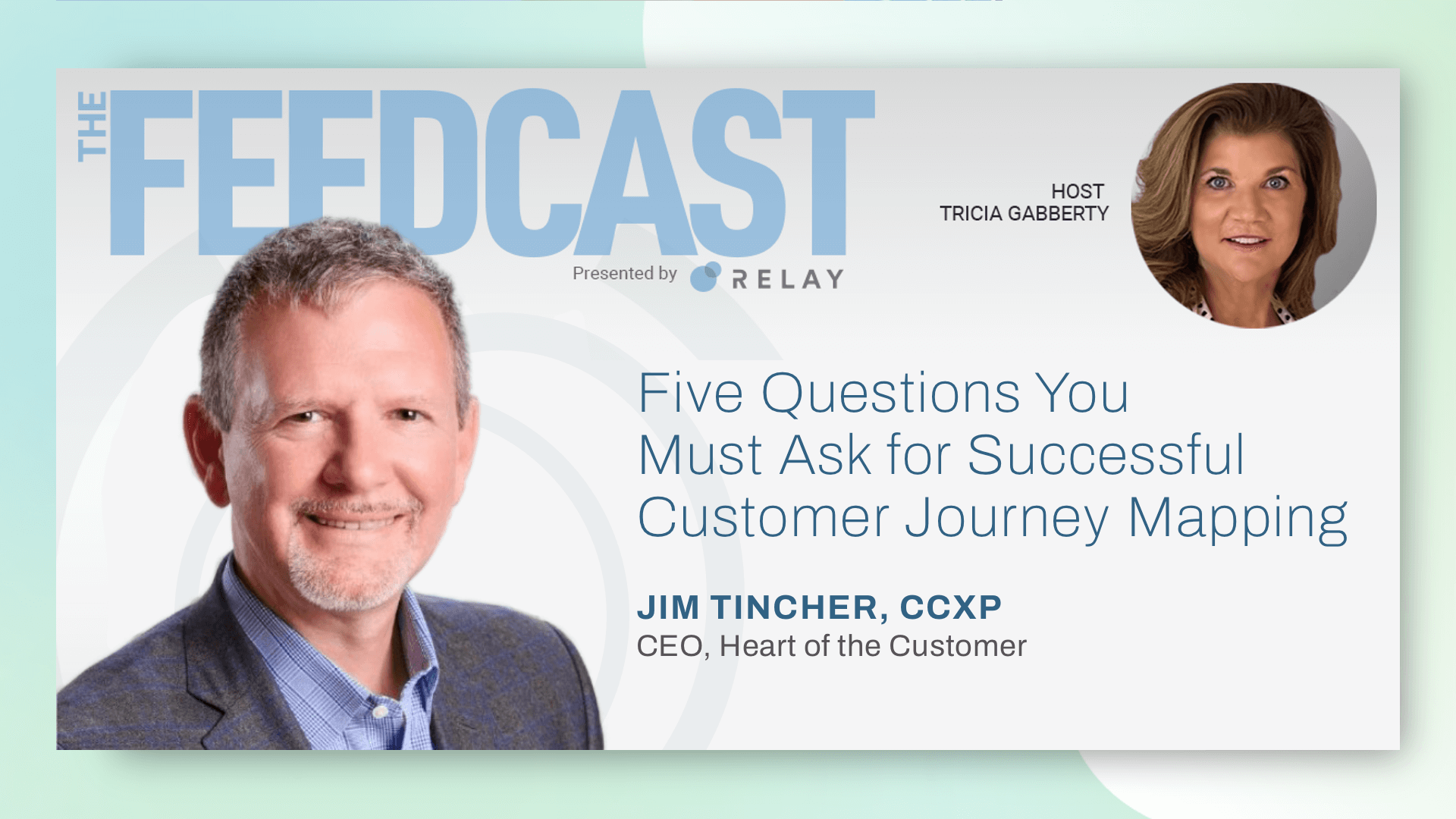The FeedCast:
Five Questions You Must Ask for Successful Customer Journey Mapping
Featuring Jim Tincher, CEO, Heart of the Customer

Listen or watch to the episode below
Listen and follow “The FeedCast” on the following platforms:
Apple | Spotify | Amazon | Google
The latest episode of The Feedcast, the monthly podcast created and produced by Relay Network featured a discussion between host, Tricia Gabberty, and Jim Tincher, CEO of Heart of the Customer.
In this discussion, Jim shares the importance of getting the customer experience ‘right’, and how everyone within an organization has skin in the game. “Early in my career, I joined a large health insurance organization and found we had the most
complex products on the marketplace. When I looked into why that was, I found that literally nobody in product development had ever met a client.” This set Jim thinking about what a missed opportunity that was, with product developers essentially creating or redesigning products in a vacuum. “Having never met any clients, we were building the products that we wanted to buy and, since we were so close to the products and knew so much, we were basically building them for ourselves, not for purpose and certainly not for the average consumer.”
This prompted Jim to make his leap from product to people; notably, changing disciplines to focus more on the customer experience with a keen eye on journey mapping. Customer journey mapping allows you to visualize and analyze the various touchpoints and interactions a customer has with your business. It helps identify pain points, opportunities for improvement, and areas where you can
exceed customer expectations.

“What many companies look at is, of course, sales. And while the company I mentioned was leading the nation in sales, we also led the nation in the percentage of customers churning because of the complexity of the product suite. We had a great sales team, and we were growing, but how much more could we have grown if we were able to retain those customers?”
Jim Tincher
All of these observations led Jim to use an all-hands approach in his Heart of the Customer consulting projects. By having a client’s team all at the table to hear what the customer is saying, they are all invested and there’s no finger pointing. “The ultimate goal,” Jim continues, “is keeping the customer satisfied throughout their lifetime with your company and product. We involve sales, product, operations, the marketing teams and get them to talk with their customer, to be part of the interviews so that I don’t have to tell them what the results were. They have heard them firsthand.” This sets a company up for success by making those participants
customer advocates within the organization.
As for the success rate of customer journey mapping, it was cited that two thirds of organizations that do customer journey mapping were not happy with their results. When asked why, it was because nothing changed. In Jim’s experience a customer journey map is doomed to fail without asking the following five questions:
1.) What is the business problem we are trying to solve? If you don’t start with this question, you may be going after things that don’t matter to the business and you won’t get the [right] resources.
2.) Which journey do you want to map? – broadly, from end to end? Or is there a specific part of the journey where we are seeing challenges?
3.) Which customers? Meaning, those who are complaining, those who are attriting, new customers that are onboarding? Be sure to segment
4.) What’s the right approach? – Give the voice to the customer
5.) Who’s on the team? This is the most important question and Jim advises its better to assemble a large team if you are truly serious about actually making changes: ‘I’d rather have too many people on the team so that you are hitting
all the different touchpoints, breaking down the silos.”
Metrics play a crucial role in measuring customer experience and satisfaction. These metrics can include Net Promoter Score (NPS), Customer Satisfaction Score (CSAT), Customer Effort Score (CES), and more, however, tying back these metrics to customer behavior is essential. Understanding how specific behaviors and interactions impact customer satisfaction allows you to make data-driven decisions and improvements. By analyzing customer behavior, you can identify patterns, trends, and areas to focus on for delivering exceptional customer experiences.
Jim went on to share that many CEO’s drift away from the customer experience because it is not in their day to day purview. An imperative, Jim says, is to be sure that the CEO is talking to customers on a regular basis. He takes it a step further by advising that all roles need to speak to each other: Marketing to Sales, Finance, Operations, etcetera, and vice versa. “In order to create change, you have to speak to the two most influential roles and that is the CFO and the COO. By establishing an ongoing relationship with Finance and Operations, you create a heightened sense of awareness around the customer experience.” Remember, a customer-centric approach is key for building long-lasting relationships with your customers and fostering loyalty. By prioritizing the customer and focusing on customer journey mapping, you can continuously improve the customer experience and drive business growth.
To hear the full podcast interview with Jim Tincher, click here.
To experience a Relay Feed for yourself, click here.
If you are interested in subscribing to the FeedCast, please fill out the form below.